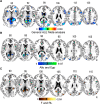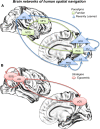Neuropsychology of environmental navigation in humans: review and meta-analysis of FMRI studies in healthy participants
- PMID: 24488500
- PMCID: PMC4010721
- DOI: 10.1007/s11065-014-9247-8
Neuropsychology of environmental navigation in humans: review and meta-analysis of FMRI studies in healthy participants
Abstract
In the past 20 years, many studies in the cognitive neurosciences have analyzed human ability to navigate in recently learned and familiar environments by investigating the cognitive processes involved in successful navigation. In this study, we reviewed the main experimental paradigms and made a cognitive-oriented meta-analysis of fMRI studies of human navigation to underline the importance of the experimental designs and cognitive tasks used to assess navigational skills. We performed a general activation likelihood estimation (ALE) meta-analysis of 66 fMRI experiments to identify the neural substrates underpinning general aspects of human navigation. Four individual ALE analyses were performed to identify the neural substrates of different experimental paradigms (i.e., familiar vs. recently learned environments) and different navigational strategies (allocentric vs. egocentric). Results of the general ALE analysis highlighted a wide network of areas with clusters in the occipital, parietal, frontal and temporal lobes, especially in the parahippocampal cortex. Familiar environments seem to be processed by an extended temporal-frontal network, whereas recently learned environments require activation in the parahippocampal cortex and the parietal and occipital lobes. Allocentric strategy is subtended by the same areas as egocentric strategy, but the latter elicits greater activation in the right precuneus, middle occipital lobe and angular gyrus. Our results suggest that different neural correlates are involved in recalling a well-learned or recently acquired environment and that different networks of areas subtend egocentric and allocentric strategies.
Figures




Similar articles
-
The human parahippocampal cortex subserves egocentric spatial learning during navigation in a virtual maze.Neurobiol Learn Mem. 2010 Jan;93(1):46-55. doi: 10.1016/j.nlm.2009.08.003. Epub 2009 Aug 13. Neurobiol Learn Mem. 2010. PMID: 19683063
-
Common and distinct neural trends of allocentric and egocentric spatial coding: An ALE meta-analysis.Eur J Neurosci. 2021 Jun;53(11):3672-3687. doi: 10.1111/ejn.15240. Epub 2021 May 10. Eur J Neurosci. 2021. PMID: 33880818
-
Human spatial navigation: Neural representations of spatial scales and reference frames obtained from an ALE meta-analysis.Neuroimage. 2021 Sep;238:118264. doi: 10.1016/j.neuroimage.2021.118264. Epub 2021 Jun 12. Neuroimage. 2021. PMID: 34129948 Review.
-
Navigation ability dependent neural activation in the human brain: an fMRI study.Neurosci Res. 2006 Aug;55(4):361-9. doi: 10.1016/j.neures.2006.04.009. Epub 2006 Jun 2. Neurosci Res. 2006. PMID: 16735070
-
Commonalities and specificities between environmental navigation and autobiographical memory: A synthesis and a theoretical perspective.Neurosci Biobehav Rev. 2021 Aug;127:928-945. doi: 10.1016/j.neubiorev.2021.06.012. Epub 2021 Jun 6. Neurosci Biobehav Rev. 2021. PMID: 34102149 Review.
Cited by
-
EMDR therapy for PTSD after motor vehicle accidents: meta-analytic evidence for specific treatment.Front Hum Neurosci. 2015 Apr 21;9:213. doi: 10.3389/fnhum.2015.00213. eCollection 2015. Front Hum Neurosci. 2015. PMID: 25954183 Free PMC article.
-
Rapid and independent memory formation in the parietal cortex.Proc Natl Acad Sci U S A. 2016 Nov 15;113(46):13251-13256. doi: 10.1073/pnas.1605719113. Epub 2016 Nov 1. Proc Natl Acad Sci U S A. 2016. PMID: 27803331 Free PMC article.
-
Is implicit Level-2 visual perspective-taking embodied? Spontaneous perceptual simulation of others' perspectives is not impaired by motor restriction.Q J Exp Psychol (Hove). 2022 Jul;75(7):1244-1258. doi: 10.1177/17470218221077102. Epub 2022 Feb 25. Q J Exp Psychol (Hove). 2022. PMID: 35040382 Free PMC article.
-
A penny for your thoughts! patterns of fMRI activity reveal the content and the spatial topography of visual mental images.Hum Brain Mapp. 2015 Mar;36(3):945-58. doi: 10.1002/hbm.22678. Epub 2014 Oct 31. Hum Brain Mapp. 2015. PMID: 25359694 Free PMC article.
-
Egocentric Navigation Abilities Predict Episodic Memory Performance.Front Hum Neurosci. 2020 Nov 27;14:574224. doi: 10.3389/fnhum.2020.574224. eCollection 2020. Front Hum Neurosci. 2020. PMID: 33328930 Free PMC article.
References
Publication types
MeSH terms
LinkOut - more resources
Full Text Sources
Other Literature Sources
Miscellaneous

